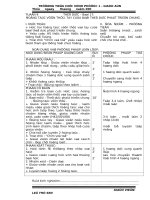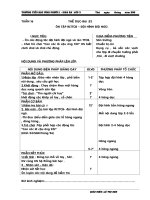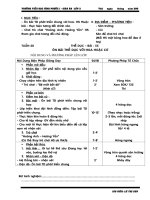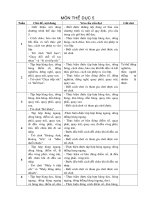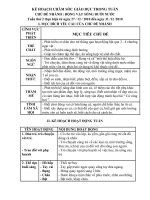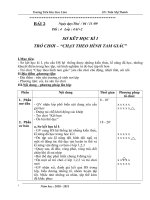Tài liệu People Make the City,’’ Executive Summary - Joint Urban Operations Observations and Insights from Afghanistan and Iraq pdf
Bạn đang xem bản rút gọn của tài liệu. Xem và tải ngay bản đầy đủ của tài liệu tại đây (427.28 KB, 86 trang )
This document and trademark(s) contained herein are protected by law
as indicated in a notice appearing later in this work. This electronic
representation of RAND intellectual property is provided for non-
commercial use only. Permission is required from RAND to reproduce, or
reuse in another form, any of our research documents.
Limited Electronic Distribution Rights
Visit RAND at www.rand.org
Explore RAND National Defense
Research Institute
View document details
For More Information
This PDF document was made available
from www.rand.org as a public service of
the RAND Corporation.
6
Jump down to document
THE ARTS
CHILD POLICY
CIVIL JUSTICE
EDUCATION
ENERGY AND ENVIRONMENT
HEALTH AND HEALTH CARE
INTERNATIONAL AFFAIRS
NATIONAL SECURITY
POPULATION AND AGING
PUBLIC SAFETY
SCIENCE AND TECHNOLOGY
SUBSTANCE ABUSE
TERRORISM AND
HOMELAND SECURITY
TRANSPORTATION AND
INFRASTRUCTURE
WORKFORCE AND WORKPLACE
The RAND Corporation is a nonprofit
research organization providing
objective analysis and effective
solutions that address the challenges
facing the public and private sectors
around the world.
Purchase this document
Browse Books & Publications
Make a charitable contribution
Support RAND
This product is part of the RAND Corporation monograph series.
RAND monographs present major research findings that address the
challenges facing the public and private sectors. All RAND mono-
graphs undergo rigorous peer review to ensure high standards for
research quality and objectivity.
Russell W. Glenn, Christopher Paul,
Todd C. Helmus, Paul Steinberg
Prepared for the United States Joint Forces Command
Approved for public release; distribution unlimited
“People Make
the City,”
Executive Summary
Joint Urban Operations
Observations and Insights from
Afghanistan and Iraq
The RAND Corporation is a nonprofit research organization providing
objective analysis and effective solutions that address the challenges
facing the public and private sectors around the world. RAND’s
publications do not necessarily reflect the opinions of its research clients
and sponsors.
R
®
is a registered trademark.
© Copyright 2007 RAND Corporation
All rights reserved. No part of this book may be reproduced in any
form by any electronic or mechanical means (including photocopying,
recording, or information storage and retrieval) without permission in
writing from RAND.
Published 2007 by the RAND Corporation
1776 Main Street, P.O. Box 2138, Santa Monica, CA 90407-2138
1200 South Hayes Street, Arlington, VA 22202-5050
4570 Fifth Avenue, Suite 600, Pittsburgh, PA 15213-2665
RAND URL: />To order RAND documents or to obtain additional information, contact
Distribution Services: Telephone: (310) 451-7002;
Fax: (310) 451-6915; Email:
The research described in this report was sponsored by the United States
Joint Forces Command. The research was conducted in the RAND
National Defense Research Institute, a federally funded research and
development center sponsored by the Office of the Secretary of Defense,
the Joint Staff, the Unified Combatant Commands, the Department
of the Navy, the Marine Corps, the defense agencies, and the defense
Intelligence Community under Contract DASW01-01-C-0004.
Library of Congress Cataloging-in-Publication Data
Glenn, Russell W.
“People make the city,” executive summary : joint urban operations observations
and insights from Afghanistan and Iraq / Russell W. Glenn [et al.].
p. cm.
Includes bibliographical references.
ISBN 978-0-8330-4153-1 (pbk. : alk. paper)
1. Urban warfare. 2. Street fighting (Military science) I. Title.
U167.5.S7G58421 2007
355.4'26—dc22
2007017600
iii
Preface
Ongoing operations in the villages, towns, and cities of Afghanistan
and Iraq offer the first real test of the United States’ first-ever joint
urban operations doctrine, which was published in 2002. is execu-
tive summary provides a top-line synthesis of joint urban operations
observations and insights taken from thousands of pages of hard-copy
and online material and from 102 interviews relating to Operation
Enduring Freedom (OEF) and Operation Iraqi Freedom (OIF). When-
ever an individual is quoted or otherwise associated with particular
remarks, it is with the individual’s explicit permission to be recognized
for those contributions. is monograph should provide rich source
material for tailoring the new doctrine, as presented in Joint Publica-
tion (JP) 3-06,
1
and for the training, acquisition, and force structure
initiatives that together must constantly adapt if they are to prepare
U.S. forces properly for urban challenges yet to come.
e time frame for the study corresponds to two collection phases.
Phase I was conducted from October 2003 to April 2004, while phase
II was conducted during three months, from July 1, 2004, through
September 30, 2004. e results of a third phase of the study are pub-
lished under separate cover.
2
is executive summary provides public access to material from
a document not available to the general public, in the interest of
1
Joint Chiefs of Staff (2002).
2
Glenn and Helmus (2007).
iv “People Make the City,” Executive Summary
informing and stimulating further research of value to our personnel
in the field.
3
is monograph will be of interest to individuals in the govern-
ment, nongovernmental organizations, private volunteer organizations,
and the commercial sector whose responsibilities include planning,
policy, doctrine, training, and the conduct of actions undertaken in or
near urban areas in both the immediate future and the longer term.
is research was sponsored by the Joint Urban Operations
Office, J9, Joint Forces Command and conducted within the Inter-
national Security and Defense Policy Center of the RAND National
Defense Research Institute, a federally funded research and develop-
ment center sponsored by the Office of the Secretary of Defense, the
Joint Staff, the Unified Combatant Commands, the Department of the
Navy, the Marine Corps, the defense agencies, and the defense Intel-
ligence Community.
For more information on RAND’s International Security and
Defense Policy Center, contact the Director, James Dobbins. He can
be reached by email at ; by phone at 703-
413-1100, extension 5134; or by mail at RAND Corporation, 1200
South Hayes Street, Arlington, Virginia 22202-5050. More informa-
tion about RAND is available at www.rand.org.
3
Glenn, Paul, and Helmus (2007).
Contents
v
Preface iii
Table
ix
Summary
xi
Abbreviations
xxi
CHAPTER ONE
Introduction 1
Background
1
Objectives and Approach
3
Organization of is Document
4
CHAPTER TWO
ree Overarching Synthesis Observations 7
e “ree-Block War” Is the Reality During Modern
Urban Operations
7
Orchestrating Urban Military and Civil Activities in Support of
Strategic Objectives Is Fundamental to National and
Coalition Success
8
Urban Operations Increasingly Characterize U.S. and Coalition
Undertakings
11
CHAPTER THREE
Observations and Insights: Understand 13
At a Minimum, Transition to Civil Authority, Not Actions
on the Objective, Should Be the Point from Which to Initiate
Backward Planning; It Will Often Be Necessary to Look
Even Deeper in Time
13
Considering Second- and Higher-Order Effects of Actions Is
Essential—ose Effects Can Be Counterintuitive
14
Studies of Former Urban Operations Show a Need to Modify U.S.
Military Capabilities
15
Joint and Service Intelligence Processes and Organizations
15
Acquisition
17
Training
18
Combat Service Support
20
Doctrine
21
Irregular Warfare Lessons Can Be of Value in Addressing the
Urban Warfare Challenges
22
Decentralization Is Essential to Accomplishing Urban Operations
Missions—but Is Not Risk-Free
23
Urban Combat Operations Confront Commanders with a
“Dilemma of Force”
24
CHAPTER FOUR
Observations and Insights: Shape 27
Shaping Noncombatant, Enemy, and Other Urban Perceptions
Should Be Designed, War-Gamed, and Conducted
as a Campaign
27
Managing Expectations Is Critical to Successful Shaping
28
Cultural Understanding Is Key to Every Aspect of Urban
Operations Success
30
How Much the Military Will Be a Social Engineering Tool
Should Be Determined Before Operations
30
ere Is a Call for an Effective Way to Measure Shaping
Effectiveness
31
e United States Needs to Better Assess Initial Indigenous
Population Perceptions—with Forces Prepared to React
Appropriately to Changes in Attitude
32
vi “People Make the City,” Executive Summary
CHAPTER FIVE
Observations and Insights: Engage 35
While “Speak Softly and Carry a Big Stick” May Sometimes
Be Good Advice, Good Judgment Must Be Used in Applying
the Stick
35
Regular-SOF Fratricide in Urban Areas Remains a Significant
reat
36
Contractors Play a Fundamental Role, but eir Status and Roles
Must Be Better Defined
37
How Urban Environments Affect Vehicle Design, Aviation
Operations, and System Acquisition Has Not Generally
Received Enough Attention
39
CHAPTER SIX
Observations and Insights: Consolidate 41
e Greatest Obstacles to Accomplishing Strategic Objectives May
Come After Urban Combat
41
e U.S. Military Could Better Capitalize on the Expertise of
Coalition Members
43
Money and Its Management Are Key to Urban Operations Success
44
e Organization and Alignment of Military and Civil
Reconstruction Organizations Should Parallel eir
Indigenous Counterparts
45
Consolidation Should Begin When an Urban Operation Begins
and Is Cause to Reconsider Traditional Perceptions About
Command Functions
46
CHAPTER SEVEN
Observations and Insights: Transition 49
Coalition Members Should Be Aware of Possible “Mutinies”
by Some Indigenous Elements as Established Departure
Dates or Other Critical Events Approach
49
ough Not Feasible Because of Political Constraints, Urban
Stability Operations Should Be Driven by End State,
Not End Date
50
Contents vii
viii “People Make the City,” Executive Summary
Beware the Insurgent-to-Criminal Evolution 51
Balance Short- and Long-Term Perspectives—Today’s Challenges
May Veil Tomorrow’s
52
CHAPTER EIGHT
Tactical Observations and Insights: Selected Offerings 53
CHAPTER NINE
e Street Ahead: How the Past Should Influence Preparations
for the Future
57
Concept and Master Plan Conceptualizations and Approaches
57
Orchestrating Service, Joint, Multinational, and
Interagency Resources
58
Specific Areas in Need of Attention
59
References
61
Table
ix
8.1. Tactical Observations and Insights: Selected Offerings 54
xi
Summary
Introduction
Today’s strategic environment implies an obligation to preserve inno-
cent life when possible and to rebuild that which war destroys. Soma-
lia and East Timor, Afghanistan and Iraq: Recent contingencies dem-
onstrate that cities, towns, and villages are the primary focus of that
destruction and reconstruction. It is there that national and local econ-
omies are centered. It is from those concentrations of humanity that
governance originates. It is men and women in urban ports, airfields,
or warehouse complexes who distribute aid in times of need. It is from
cities that modern communications come and to cities that students
go to obtain higher education. Urban areas are the keys to nations
“because that’s where all the people are,”
1
and it is people who make
nations just as they make cities.
2
e objective of this study was to reveal tools that will better
enable military and civilian alike to meet national policy objectives
best through more effective conduct of urban combat and restoration.
1
Lau (1998).
2
is turn of phrase and the title of this monograph derive from the following quotation:
“Men make the city, and not walls or ships with no men inside them” (ucydides, 1972,
p. 530). ucydides uses “men” to distinguish between his soldiers (and other individuals to
a lesser extent) and what are felt to be the less important, nonhuman components of the city
that he addresses. “Men” still pertains to coalition soldiers in its modern application (and, by
extension, those in other organizations aiding in the recovery and transition of Afghanistan
and Iraq), but now the expression encompasses individuals of both sexes who serve in mili-
tary (and other) organizations.
xii “People Make the City,” Executive Summary
To do so, the study drew heavily on written material and interviews
pertaining to OEF (Afghanistan) and OIF. Written information used
includes thousands of pages of hard-copy and electronic material, much
of it from military personnel still serving in theater at the time of its
writing. Interviews included those with members of the U.S., UK, and
Australian armed forces and civilians working to reconstruct Iraq. e
military personnel represent the four service arms and both regular and
special operations organizations.
e time frame for the study corresponds to two collection
phases. Phase I was conducted from October 2003 to April 2004, while
phase II was conducted during three months, from July 2004 to Sep-
tember 2004. e results of a third phase of the study will be published
under separate cover.
Three Overarching Synthesis Observations
Drawing from both the written sources and the interviews, we present
three overarching observations that are particularly relevant in demon-
strating the character or influence of joint urban undertakings.
The “Three-Block War” Is the Reality During Modern Urban
Operations
Former Commandant of the Marine Corps General Charles Krulak
once described urban operations in terms of what he called the three-
block war. A unit operating in a built-up area could find itself providing
support to the indigenous population (block one), helping to restore or
maintain stability (block two), and fighting an armed foe in force-on-
force combat (block three). Further, these events could occur simul-
taneously and on contiguous blocks. e metaphor was found to be a
valid one by those in the field. Marine and soldier, U.S. and UK service
representative alike recalled General Krulak’s model and declared that
it accurately depicted the scope of challenges that a force finds itself
confronting in villages, towns, and cities during combat operations.
e difficulty is that military forces are not staffed or equipped to
handle concurrently the myriad tasks encompassed by the three blocks.
erefore, the three-block war not only presents a planning challenge,
but also constitutes a resource-allocation nightmare.
The Importance of Orchestrating Urban Military and Civil Activities
in Support of Strategic Objectives Is Fundamental to National and
Coalition Success
Given that these modern ground forces are allocated personnel and
materiel sufficient only for combat or supporting forces conducting a
fight, the activities of other agencies capable of bringing further ele-
ments of national power to bear should be well orchestrated with those
in the U.S. Department of Defense (DoD). is was not the case
during early operations in 2003 Iraq. e delineation of responsibili-
ties and orchestration of capabilities between DoD and other federal,
nongovernmental, or private volunteer organizations was unsatisfac-
tory. Improvement on the part of all participants is called for.
Urban Operations Increasingly Characterize the General Character
of U.S. and Coalition Undertakings
World urbanization (approximately half of the world’s population now
resides in urban areas) and the force-projection character of the U.S.
armed forces increasingly means that virtually any military action will
involve activities in built-up areas. Ports and airfields are fundamental
to force projection. Urban operations are almost inevitable, as these are
often adjacent to, or embedded in, larger urban areas and, in fact, are
inherently urban in character themselves. Further, the importance of
cities as social, economic, diplomatic, cultural, transportation, and other
types of hubs means that coalition objectives will generally require mili-
tary forces to conduct operations in these areas. e complexity of such
undertakings—dealing with heterogeneous demographic groups, main-
taining infrastructure support, and coordinating media requirements, to
name but three—is far greater in densely packed urban environs. ere-
fore, this concentration of demands will also come to be the norm for
military and other leaders. However, there is good news amid these chal-
lenges. Such density and complexity are rarely found in any other type of
environment. us, a force qualified to meet such demands is likely able
to apply its expertise and accomplish its missions virtually anywhere.
Summary xiii
xiv “People Make the City,” Executive Summary
Twenty-Five Synthesis Observations and Insights
Beyond the three overarching observations, we provide 25 other obser-
vations and highlights organized using the joint urban doctrine opera-
tional construct of understand, shape, engage, consolidate, and transi-
tion (USECT). ese five phases of an urban operation were introduced
to joint doctrine in the September 2002 JP 3-06, Doctrine for Joint
Urban Operations.
3
eir definitions are summarized as follows:
• Understand—Understand the nature of the conflict, the enemy,
the battlefield, and the nature of the indigenous population and
culture.
4
• Shape—Create favorable conditions for the engage and consoli-
date phases. Influence the strategic setting, control of the physical
environment, civilian population, and red options in ways favor-
able to friendly-force success while increasing blue options.
5
• Engage—Take action against a hostile force or to influence a polit-
ical situation or natural or humanitarian predicament favorably.
6
• Consolidate—Protect what has been gained. Restore security
and infrastructure.
7
• Transition—Return control to civilian authorities.
8
Here, we list the observations and insights in list form; the main
document expands on each one.
3
Joint Chiefs of Staff (2002).
4
Joint Chiefs of Staff (2002, pp. II-8–II-10).
5
Joint Chiefs of Staff (2002, pp. II-10–II-11). e authors found that shaping activities are
better envisioned as beginning before the initiation of operations and continuing through
the transition phase rather than being seen as supporting only the engage and consolidate
elements of the USECT framework. Red and blue refer to enemy and friendly forces, respec-
tively. e nomenclature is drawn from the colors used to represent the adversarial forces
during most U.S. military exercises.
6
Joint Chiefs of Staff (2002, p. II-12).
7
Joint Chiefs of Staff (2002, pp. II-12–II-13).
8
Joint Chiefs of Staff (2002, p. II-13).
Observations and Insights: Understand
At a minimum, transition to civil authority, not actions on the
objective, should be the point from which to initiate backward
planning; it will often be necessary to look even deeper in time.
It is essential to consider the second- and higher-order effects
of actions taken during urban operations. ose effects can be
counterintuitive.
Studies of former urban operations, most notably OEF and OIF,
demonstrate that there is a need to modify U.S. joint and service
intelligence processes and organizations, acquisition, training,
support procedures, and doctrine.
Irregular warfare, like urban operations, is very much influenced
by noncombatants. Lessons from the former can be of value in
addressing the latter.
Decentralization, and therefore good junior leadership, is essential
to urban operations mission accomplishment. However, decen-
tralization can make it more difficult to gain compliance within
one’s own force, especially in the normally highly heterogeneous
urban environment.
Urban combat operations confront commanders with a “dilemma
of force.”
Observations and Insights: Shape
Shaping of noncombatant, enemy, and other urban perceptions
should be designed, war-gamed, and conducted as a campaign.
Management of expectations is critical to successful shaping.
Cultural understanding is key to every aspect of urban operations
success.
e extent to which the military is to be a social-engineering tool
should be determined prior to operations.
ere is a call for an effective way of measuring shaping effort
effectiveness.
•
•
•
•
•
•
•
•
•
•
•
Summary xv
xvi “People Make the City,” Executive Summary
e United States needs to assess initial indigenous population
perceptions better. Its forces should be prepared to react appropri-
ately to changes in attitude.
Observations and Insights: Engage
“Speak softly and carry a big stick” is sometimes good advice
during urban operations, though the stick has to be applied with
good judgment.
Regular–special operations force fratricide in urban areas remains
a significant threat.
Contractors play a fundamental role in urban operations. eir
status and roles require better definition.
e effects of urban environments on vehicle design, aviation
operations, and system acquisition in general have for too long
received insufficient attention.
Observations and Insights: Consolidate
e greatest obstacles to accomplishing strategic objectives may
come after urban combat.
e U.S. military could better capitalize on the expertise of coali-
tion members.
Money and its management are key to urban operations success.
e organization or alignment of military and civil recon-
struction organizations should parallel that of their indigenous
counterparts.
Consolidation should begin when urban operations are initiated,
which, given the prevalence of urban operations, is cause to recon-
sider the traditional perceptions about command functions.
Observations and Insights: Transition
Coalition members should be aware of possible “mutinies” by
some indigenous elements as established departure dates or other
critical events approach.
•
•
•
•
•
•
•
•
•
•
•
ough it may not be feasible because of political constraints,
urban stability operations should be driven by an end state, not
an end date.
Beware the insurgency-to-criminal evolution.
Balance short- and long-term perspectives. e challenges of
today may be veiling those of tomorrow.
Selected Tactical Observations and Insights
e focus of this analysis is at the operational and strategic levels. How-
ever, some tactical observations have direct operational or strategic
impact; in fact, in some cases, they underlie the operational and strate-
gic implications discussed. e full list of such observations is included
in the main document organized by the USECT construct; here, we
highlight one example from each, with the exception of Transition:
Vehicle tactics, techniques, and procedures (TTP) differ in an
urban environment (understand).
Maneuver units need to be more comfortable with human exploi-
tation teams (HETs) and psychological operations (PSYOP) capa-
bilities (shape).
Urban engagement ranges are short; training should reflect this
(engage).
e intimidation value of any method erodes quickly with use
(consolidate).
The Street Ahead: How the Past Should Influence
Preparations for the Future
is concluding section considers how the joint urban doctrine, inte-
grating concept, master plan, and those events might be modified given
the observations and insights collected and analyzed in this research
effort. It covers three areas: (1) the concept and master plan for funda-
mental conceptualizations of urban operations and related approaches
•
•
•
•
•
•
•
Summary xvii
xviii “People Make the City,” Executive Summary
to addressing the future; (2) how those approaches influence service,
joint, multinational, and interagency cooperation and what changes
might be beneficial; and (3) specific elements meriting inclusion in
future drafts of the concept and master plan.
Concept and Master Plan Conceptualizations and Approaches
JP 3-06 is generally well conceived, but its orientation is too adversary-
centric. We are not arguing for devoting less attention to finding ways
to defeat an urban foe. Rather, we suggest that the scope of the concept
be expanded to account better for those aspects of the three-block war
(or, at the operational level, of stability and support operations) that
may not include a foe or in which enemy activity is not of preeminent
importance.
A second area that would benefit from such broadening is that
involving conceptualization of the urban environment itself. e doc-
trine, concept, and related materials recognize the mutual importance
of the physical topography (used here to refer to inanimate elements of
the environment, such as buildings and infrastructure hardware) and
urban human features, but the focus is too great on the former.
ird, the doctrine as outlined in JP 3-06 and the concepts cre-
ated for implementing it and carrying it forward in time (USECT)
are little alike, even though they have a lot in common. A superior
construct may come along. But until that time, it would be helpful to
employ the USECT construct to simplify what is inherently an already
extremely challenging undertaking, given the inherent complexity of
urban environments.
Finally, urban areas are nodes, center points with tentacles that
reach out to influence areas beyond their limits. ose tentacles range
from physical manifestations (such as roads, tracks, and air routes) to
less concrete manifestations, such as economic influence and politi-
cal governance. Although this is common knowledge, few military
sources investigate the nature of these beyond-the-city relationships
and their influences on combat and postcombat operations. Recent
events in Brčko, Bosnia and Herzegovina, and in Baghdad offer
excellent case studies that would serve both joint urban doctrine and
future concepts well.
Orchestrating Service, Joint, Multinational, and Interagency
Resources
e importance of interagency cooperation is directly related to these
dual elements of human primacy and cities as network components.
However, there is too little guidance for the numerous agencies that
have vital roles in seizing, controlling, and restoring urban environ-
ments. Although the lack of interagency guidance is frequently little
more than an annoyance or point of disgruntlement in other environ-
ments, it is a crippling shortfall in towns and cities.
Many of the changes suggested by urban operations during OEF
and OIF, such as making major modifications to current intelligence
procedures, should be joint and interagency cooperative efforts. In par-
ticular, the full development of shaping campaigns as a concept and the
actual writing of those campaign plans requires service and interagency
collaboration. Developing concepts for determining and modeling
second- and higher-order effects and fielding those concepts facilitating
backward planning from an end state as defined in terms of strategic
and transition-driven objectives will likewise demand knowledgeable
oversight and involvement by multiple agencies and services.
Specific Areas in Need of Attention
Drawing on the research, we highlight five specific areas in need of
attention:
ere is a need to expand the concept of consolidation to one
that overlaps all aspects of preparation, execution, and postcom-
bat activities during an urban operation.
Shaping campaigns should incorporate the capabilities of entire
commands in support of civil affairs and related efforts to win the
indigenous population’s trust and confidence.
Military training and education should be expanded to include
greater instruction on phase 4 responsibilities.
9
9
Phase 4 incorporated the postcombat aspects of U.S. Central Command’s (USCENTCOM’s)
campaign plan, with phase 3 being the primary combat phase. Use of “phase 4” in discus-
sions about OIF therefore generally refers to stability or support matters related to Iraq’s
recovery.
•
•
•
Summary xix
xx “People Make the City,” Executive Summary
Command and staff functions should be adapted to meet the
demands of urban operations complexity and density better.
Systems should be designed, developed, and acquired that are
better suited for urban operations. Specifications should keep
urban operations in mind.
•
•
xxi
Abbreviations
BFT Blue Force Tracker
C2 command and control
CA civil affairs
CPA Coalition Provisional Authority
CS combat support
CSS combat service support
DoD U.S. Department of Defense
FARC Fuerzas Armadas Revolucionarias de Colombia
(Revolutionary Armed Forces of Colombia)
FRL former regime loyalists
HET human exploitation team
HMMWV high-mobility, multipurpose, vehicle
HUMINT human intelligence
IED improvised explosive device
IO information operations
JP joint publication
JUO joint urban operations
xxii “People Make the City,” Executive Summary
MOUT military operations on urbanized terrain
MRE meal, ready to eat
NGO nongovernmental organization
OEF Operation Enduring Freedom
OIF Operation Iraqi Freedom
OODA observe, orient, decide, act
PSYOP psychological operations
PVO private volunteer organization
SEAD suppression of enemy air defenses
SOF special operations forces
TTP tactics, techniques, and procedures
USCENTCOM U.S. Central Command
USECT understand, shape, engage, consolidate, transition
1
CHAPTER ONE
Introduction
Background
Although it would seem rather obvious that the people in urban areas
are a prime consideration in thinking about urban warfare, only in the
past several years has the U.S. military formally recognized the funda-
mental importance of human occupants in urban areas. As recently as
1998, both the U.S. Army and Marine Corps wrote of such undertak-
ings in terms of military operations on urbanized terrain (MOUT),
defined as “all military actions planned and conducted on a topograph-
ical complex and its adjacent terrain where manmade construction is
the dominant feature.”
1
However, U.S. understanding of urban operations has under-
gone a dramatic, fundamental, and yet largely unnoticed transition
since then. e term MOUT is now passé doctrinally, having been
replaced by the term urban operations and an inherent understand-
ing that “manmade construction or the density of noncombatants are
the dominant features”
2
in such operations. Physical topography—
1
U.S. Marine Corps (1998, pp. 1–2). e equivalent U.S. Army publication referred to
MOUT slightly differently:
Military
Operations on Urbanized Terrain include all military actions that are planned
and conducted on a terrain complex where manmade construction impacts on the tacti-
cal operations available to the commander. (U.S. Department of the Army, 1979, p. I,
emphasis in original)
2
is entry (emphasis added) is taken from the joint definition as it appears in Joint Chiefs
of Staff (2002, p. vii). e complete definition is “Joint urban operations (JUO) are all joint
operations planned and conducted across the range of military operations on, or against
